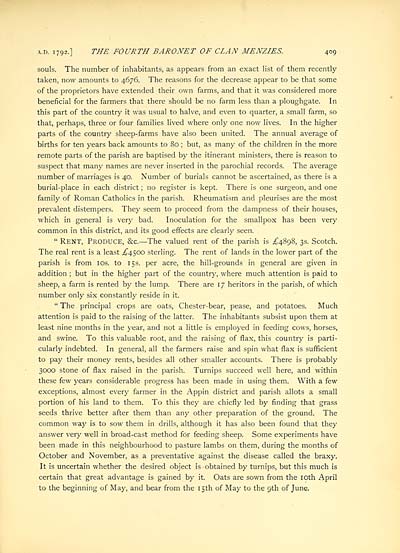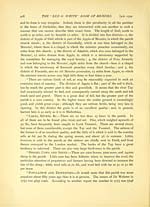Red and white book of Menzies
(517) Page 409
Download files
Complete book:
Individual page:
Thumbnail gallery: Grid view | List view

a.d. 1792.] THE FOURTH BARONET OF CLAN MENZIES. 409
souls. The number of inhabitants, as appears from an exact list of them recently
taken, now amounts to 4676. The reasons for the decrease appear to be that some
of the proprietors have extended their own farms, and that it was considered more
beneficial for the farmers that there should be no farm less than a ploughgate. In
this part of the country it was usual to halve, and even to quarter, a small farm, so
that, perhaps, three or four families lived where only one now lives. In the higher
parts of the country sheep-farms have also been united. The annual average of
births for ten years back amounts to 80 ; but, as many of the children in the more
remote parts of the parish are baptised by the itinerant ministers, there is reason to
suspect that many names are never inserted in the parochial records. The average
number of marriages is 40. Number of burials cannot be ascertained, as there is a
burial-place in each district ; no register is kept. There is one surgeon, and one
family of Roman Catholics in the parish. Rheumatism and pleurises are the most
prevalent distempers. They seem to proceed from the dampness of their houses,
which in general is very bad. Inoculation for the smallpox has been very
common in this district, and its good effects are clearly seen.
" Rent, Produce, &c. — The valued rent of the parish is £4898, 3s. Scotch.
The real rent is a least £4500 sterling. The rent of lands in the lower part of the
parish is from 10s. to 15s. per acre, the hill-grounds in general are given in
addition ; but in the higher part of the country, where much attention is paid to
sheep, a farm is rented by the lump. There are 17 heritors in the parish, of which
number only six constantly reside in it.
" The principal crops are oats, Chester-bear, pease, and potatoes. Much
attention is paid to the raising of the latter. The inhabitants subsist upon them at
least nine months in the year, and not a little is employed in feeding cows, horses,
and swine. To this valuable root, and the raising of flax, this country is parti-
cularly indebted. In general, all the farmers raise and spin what flax is sufficient
to pay their money rents, besides all other smaller accounts. There is probably
3000 stone of flax raised in the parish. Turnips succeed well here, and within
these few years considerable progress has been made in using them. With a few
exceptions, almost every farmer in the Appin district and parish allots a small
portion of his land to them. To this they are chiefly led by finding that grass
seeds thrive better after them than any other preparation of the ground. The
common way is to sow them in drills, although it has also been found that they
answer very well in broad-cast method for feeding sheep. Some experiments have
been made in this neighbourhood to pasture lambs on them, during the months of
October and November, as a preventative against the disease called the braxy.
It is uncertain whether the desired object is obtained by turnips, but this much is
certain that great advantage is gained by it. Oats are sown from the 10th April
to the beginning of May, and bear from the 15th of May to the 9th of June.
souls. The number of inhabitants, as appears from an exact list of them recently
taken, now amounts to 4676. The reasons for the decrease appear to be that some
of the proprietors have extended their own farms, and that it was considered more
beneficial for the farmers that there should be no farm less than a ploughgate. In
this part of the country it was usual to halve, and even to quarter, a small farm, so
that, perhaps, three or four families lived where only one now lives. In the higher
parts of the country sheep-farms have also been united. The annual average of
births for ten years back amounts to 80 ; but, as many of the children in the more
remote parts of the parish are baptised by the itinerant ministers, there is reason to
suspect that many names are never inserted in the parochial records. The average
number of marriages is 40. Number of burials cannot be ascertained, as there is a
burial-place in each district ; no register is kept. There is one surgeon, and one
family of Roman Catholics in the parish. Rheumatism and pleurises are the most
prevalent distempers. They seem to proceed from the dampness of their houses,
which in general is very bad. Inoculation for the smallpox has been very
common in this district, and its good effects are clearly seen.
" Rent, Produce, &c. — The valued rent of the parish is £4898, 3s. Scotch.
The real rent is a least £4500 sterling. The rent of lands in the lower part of the
parish is from 10s. to 15s. per acre, the hill-grounds in general are given in
addition ; but in the higher part of the country, where much attention is paid to
sheep, a farm is rented by the lump. There are 17 heritors in the parish, of which
number only six constantly reside in it.
" The principal crops are oats, Chester-bear, pease, and potatoes. Much
attention is paid to the raising of the latter. The inhabitants subsist upon them at
least nine months in the year, and not a little is employed in feeding cows, horses,
and swine. To this valuable root, and the raising of flax, this country is parti-
cularly indebted. In general, all the farmers raise and spin what flax is sufficient
to pay their money rents, besides all other smaller accounts. There is probably
3000 stone of flax raised in the parish. Turnips succeed well here, and within
these few years considerable progress has been made in using them. With a few
exceptions, almost every farmer in the Appin district and parish allots a small
portion of his land to them. To this they are chiefly led by finding that grass
seeds thrive better after them than any other preparation of the ground. The
common way is to sow them in drills, although it has also been found that they
answer very well in broad-cast method for feeding sheep. Some experiments have
been made in this neighbourhood to pasture lambs on them, during the months of
October and November, as a preventative against the disease called the braxy.
It is uncertain whether the desired object is obtained by turnips, but this much is
certain that great advantage is gained by it. Oats are sown from the 10th April
to the beginning of May, and bear from the 15th of May to the 9th of June.
Set display mode to:
![]() Universal Viewer |
Universal Viewer | ![]() Mirador |
Large image | Transcription
Mirador |
Large image | Transcription
Images and transcriptions on this page, including medium image downloads, may be used under the Creative Commons Attribution 4.0 International Licence unless otherwise stated. ![]()
| Histories of Scottish families > Red and white book of Menzies > (517) Page 409 |
|---|
| Permanent URL | https://digital.nls.uk/96658936 |
|---|
| Description | A selection of almost 400 printed items relating to the history of Scottish families, mostly dating from the 19th and early 20th centuries. Includes memoirs, genealogies and clan histories, with a few produced by emigrant families. The earliest family history goes back to AD 916. |
|---|

